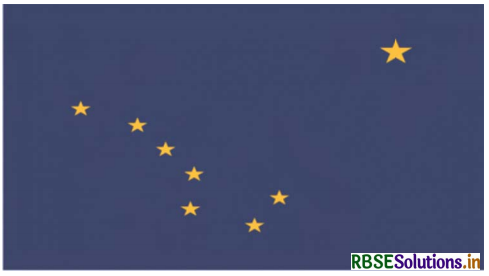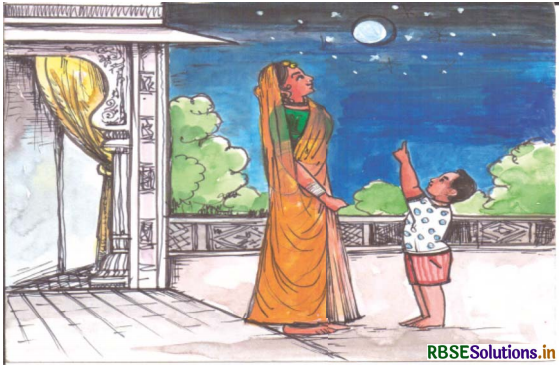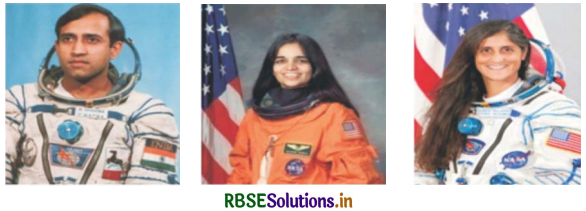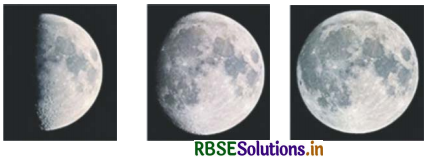RBSE Solutions for Class 5 EVS Chapter 25 Our Earth and the Space
Rajasthan Board RBSE Solutions for Class 5 EVS Chapter 25 Our Earth and the Space Textbook Exercise Questions and Answers.
The questions presented in the RBSE Solutions for Class 5 EVS are solved in a detailed manner. Get the accurate RBSE Solutions for Class 5 all subjects will help students to have a deeper understanding of the concepts.
RBSE Class 5 EVS Solutions Chapter 25 Our Earth and the Space
RBSE Class 5 EVS Our Earth and the Space Textbook Questions and Answers
Points for Discussion
Question 1.
What all have you seen in the
sky?
Answer:
We have seen the sun in the sky during the day time, and during the night time we have seen the moon and the stars.

Question 2.
Why we cannot see directly towards the sun?
Answer:
The sun shines very brightly so we cannot see directly towards it.
Explore and Write the Answers of the following:
Question 1.
Observe the Saptarishi Constellation in the sky at night and draw its picture.
Answer:

Question 2.
What else do you see in the sky? Draw their picture also.
Answer:
We see the sun, the moon, the stars etc., in the sky.

Explore and Know
Question 1.
What is the difference between an aeroplane and a spaceship?
Answer:
An aeroplane travels at lesser height while a spaceship travels at greater height, and in it, astronauts travel with a specific purpose.
Question 2.
If you go to the space, what preparations you would make?
Answer:
A special type of spaceship is required to go to the space, and an astronaut is trained in a very specific way. He/She has to do all the works in floating condition only. Besides this, we would prepare ourselves for eating different kind of food, to work in specific conditions, to live in the absence of gravitational force, and to survive ui high pressure and weightlessness, etc.
Question 3.
Which Indian astronauts have travelled to the space? Gather information about them from your school’s library.
Answer:
So far, three Indian astronauts have travelled to the space-
- Rakesh Sharma
- Sunita Williams
- Kalpana Chawala.
1. Rakesh Sharma-He is the first Indian to travel into space. He was bom on 13th January 1949 in Punjab. He flew in Soviet Space Craft Salyut7 in April 1984.
2. Sunita Williams-She was bom on 19th September 1965. She is of Indian-Slovenian descent. She went to International Space Station in 2012.
3. Kalpana Chawala-Bom on 17th March 1962, she was an Indian-American astronaut and the first woman of India to go into space. But on 10th Aug. 2012, the Space Shuttle Columbia crashed and seven astronauts including Kalpana Chawala were killed in this accident.
Question 4.
How would our earth look like, when seen from the moon?
Answer:
When seen from the moon, our earth would look small and round.
Points for Discussions :

Question 1.
Look at the figure and tell what the astronauts are wearing?
Answer:
They are wearing specific space suit with specific equipments installed in them.
Question 2.
Can we go to the space?
Answer:
Yes, we can go to the space.
Question 3.
How can we go to the space?
Answer:
We can go to the space by special spaceship.

Think and Write Answers of the Following
Question 1
Imagine that you are going on space travel. Describe your experiences of space travel in detail in your notebook.
Answer:
When I will be selected to go on space travel, then I will inform this to my relatives and friends. After that, I will get a special training to go into the space. I will practise many things such as- the practice of eating different kind of food, to work in specific conditions, to live in the absence of gravitational force, to live in high pressure and weightlessness, etc. Besides this, I will collect the information about the people who had already travelled to space, and will try to know their expreiences. In this way, only on being fully satisfied about all the things, I will go into the space.
Explore and Collect
Question 1
Gather information about the astronauts and paste their pictures in your notebook.
Answer:
The student should it themselves.
Observe and Tell the Answers of the following :
Question 1.
Write the name of the planet nearest to the sun.
Answer:
Mercury.
Question 2.
Which is the biggest planet of the solar system?
Answer:
Jupiter planet.
Question 3.
Write in sequence the names of eight planets from the sun.
Answer:
- Mercury
- Venus
- Earth
- Mars
- Jupiter
- Saturn
- Uranus
- Neptune.
Find and Answer
Question 1.
Observe the changes in the shape of the moon, in the figure given below. Draw the diagrams given below in your notebook and write the dates (tithi) on which this view of the moon is visible.

Answer:
The size of moon increases from first lunar day (Ekum) to the day of the full moon. (P

Question 2.
On the dates (tithi) correspond¬ing to the images of the moon shown above, which are the festivals, functions, fairs, etc. that we celebrate.
Answer:
Our main festivals-Holi, Diwali, Eid, Baisakhi etc. are celebrated on these dates (tithis) only.
Question 3.
Is any fair organized during these days?
Answer:
Yes, during these days, fairs are organized at some places.
Question 4.
What do the members of your family do during these days?
Answer:
During these days, all our family members get up early in the morning, take bath and then do worship or prayers. Sometimes, they go to take bath at the banks of river Ganga too. And special dishes or food items are prepared at home.
Learn, Understood and Now Tell
Question 1.
Who is the head of the solar system?
Answer:
The sun.
Question 2.
Make a list of Indian astronauts.
Answer:
- Rakesh Sharma
- Kalpana Chawala
- Sunita Williams.
Question 3.
Why are the stars not visible during day time?
Answer:
Due to extreme brightness of the sun, stars are not visible to us during day time.
Question 4.
Which planet has a ring around it?
Answer:
Saturn.

Objective Type Questions
Question 1.
Choose the right option
(i) The Pole star is seen in
(a) The East direction
(b) The South direction
(c) The West direction
(d) The North direction
Answer:
(d) The North direction
(ii) The biggest planet of the solar system is-
(a) Earth
(b) Mars
(c) Jupiter
(d) Saturn
Answer:
(c) Jupiter
(iii) The first Indian astronaut is
(a) Kalpana Chawala
(b) Sunita Williams
(c) Rakesh Sharma
(d) None of these
Answer:
(c) Rakesh Sharma
(iv) Kalpana Chawla is honoured and remembered because-
(a) She was the first women pilot
(b) She was the first Indian woman astronaut
(c) She discovered a star
(d) She was the first mountaineer
Answer:
(b) She was the first Indian woman astronaut
Question 2.
Fill in the blanks-
(a) The moon shines due to the light of the .............. only.
(b) The stars being very .............. appear so small.
(c) Mother told that the extremely bright star is the ..............
(d) The size of the moon .............. from the first lunar day (Ekum) to the day of the full moon (Pumima).
Answer:
(a) sun
(b) far
(c) pole star
(d) increases.
Match Column A and Column B :
|
Column A |
Column B |
|
A collection of the seven great sages |
Neptune |
|
The moon is not visible |
Mercury |
|
The full moon is visible |
Šaptarishi |
|
The planet farthest from thesun |
Constellation |
|
The planet nearest to the |
Purnima |
Answer:
|
Column A |
Column B |
|
A collection of the seven great sages |
Saptarishi |
|
The moon is not visible |
Constellation |
|
The full moon is visible |
Amavasya |
|
The planet farthest from thesun |
Purnima |
|
The planet nearest to the |
Neptune |
Question 4.
State True/False :
(i) The Pole Star is seen in the South direction.
(ii) In the sky there are the sun, the moon, the stars, etc.
(iii) Shape of the moon keeps on changing.
(iv) Our sun has ten planets.
(v) The Mars is the biggest planet of the solar sysem.
Answer:
(i) False
(ii) True
(iii) True
(iv) False
(v) False.
Very Short Answer Type Questions
Question 1.
Where did Babloo use to sleep with his mother?
Answer:
On the terrace.

Question 2.
How does the moon shine?
Answer:
From the light of the sun.
Question 3.
Why do the stars appear to small?
Answer:
Because they are very far.
Question 4.
When is the full moon visible?
Answer:
On the day of Purnima.
Question 5.
On which day the moon is not visible?
Answer:
On the day of Amavasya.
Question 6.
Who was the first Indian astro¬naut who travelled to the space?
Answer:
Rakesh Sharma.
Question 7.
Why is the moon called the satel¬lite brightest of the earth?
Answer:
Because it revolves round the earth.
Short/Long Answer Type Questions
Question 1.
When we look at the sky, the moon appears big, but the stars appear too small. Why?
Answer:
The moon is near the earth, and the stars are very far from the earth. Therefore, the moon appears big while the stars appear too small.
Question 2.
What do you know about the moon?
Answer:
The moon is the natural satellite of the earth which revolves round the earth. The size of the moon decreased during the dark lunar fortnight and increases from the first lunar day (ekum) to the day of the full moon (Purnima) or during the Shukla Paksha. On the day of Amavasya, the moon is not visible, while on the day of Pumima, full moon is visible.
Question 3.
What is Saptarishi Constellation? How does it look like?
Answer:
A collection of seven stars or the great sages in the sky, is called Saptarishi Constellation or Saptarishi Mandal. It ramains near about the Pole Star. Four stars form a tetragon and three stars from its tail. It appears like letter ‘P’.
Question 4.
Describe the situation of the Pole
star.
Answer:
There is an extremely bright star in the straight line direction of the upper two stars of the Seven Constellation. That brightly-shining star in the Northern direction is called the Pole Star. Its position remains fixed and it helps in deciding the direction at night for the travellers.
Question 5.
What is a spacecraft?
Answer:
A spacecraft is a specially-designed air vehicle which has all the equipments and operating systems suitable to travel into the sapce. Its flying speed is 50 times (approximately) faster than an aeroplane. It requires such a huge quan¬tity of fuel to fly that this quantity of fuel can run a car upto 200 years.
Question 6.
Explain the position and size of the moon.
Answer:
The moon is the natural and perma¬nent satellite of the earth. This does not appear same at days. Its brightness and size changes every day. On Purnima, full and the brightest moon is visible. After it (during the next fortnight), its size decreases and it is less bright. On the night of Amavasya, the moon is not visible. From the next night, its size is first small and then till the 14th day (during the fortnight), its size gradually increases an its brightness also increases.

Question 7.
Draw three figures and explain the change in the size of the moon from new moon to full moon. We do not see the moon at the same size everyday. The moon is not visible in the sky on the new moon light. After this its size gradually
Answer:

increases till the full moon and on the full moon night the moon is visible in full size. After this, its shiny size decreases again. The decreasing and increasing sequence of the moon in known as chandrakala.

- RBSE Solutions for Class 5 EVS Chapter 10 Flow of Water
- RBSE Solutions for Class 5 EVS Chapter 3 We are Special
- RBSE Solutions for Class 5 EVS Chapter 10 जल ऊपर से नीचे की ओर
- RBSE Solutions for Class 5 EVS Chapter 6 बीज बना पौधा
- RBSE Solutions for Class 5 EVS Chapter 7 Magnificence of Trees
- RBSE Solutions for Class 5 EVS Chapter 11 जल में जीवन
- RBSE Solutions for Class 5 EVS Chapter 6 Seed Becomes Plant
- RBSE Solutions for Class 5 EVS Chapter 8 The Unique World of Insects and Animals
- RBSE Solutions for Class 5 EVS Chapter 1 Understanding Our Relations
- RBSE Solutions for Class 5 EVS Chapter 2 Migration of Families
- RBSE Solutions for Class 5 EVS Chapter 9 Sources of Water